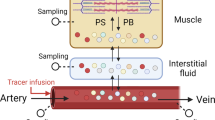Summary
D-ribose was administered orally or intravenously over at least 5 h to eight healthy volunteers and five patients with myoadenylate deaminase deficiency. Intravenous administration rates were 83, 167, and 222 mg/kg/h, which were well tolerated but oral administration of more than 200 mg/kg/h caused diarrhea. The average steady state serum ribose level ranged between 4.8 mg/100 ml (83 mg/kg/h, oral administration) and 81.7 mg/100 ml (222 mg/kg/h, intravenous administration). Serum glucose level decreased during ribose administration. The intestinal absorption rate of orally administered ribose was 87.8%–99.8% of the intake at doses up to 200 mg/kg/h without first pass effect. Urinary losses were 23% of the intravenously administered dose at 222 mg/kg/h. Ribose appeared to be excreted by glomerular filtration without active reabsorption; a renal threshold could not be demonstrated. The amount of ribose transported back from the tubular lumen depended on the serum ribose level. There was no difference in ribose turnover in healthy subjects and patients with MAD deficiency.
Similar content being viewed by others
Abbreviations
- MAD:
-
myoadenylate deaminase
- i.v.:
-
intravenous(ly)
References
Beaconsfield P, Ginsburg J (1967) Hypoglycaemia after oral ribose. Lancet 2:153
Bierman EL, Baker EM, Plough I, Hall WH (1959) Metabolism of D-ribose in diabetes mellitus. Diabetes 8:455–458
DiMauro S, Miranda AF, Hays AP, Franck WA, Hoffman GS, Schoenfeldt RS, Singh N (1980) Myoadenylate deaminase deficiency. Muscle biopsy and muscle culture in a patient with gout. J Neurol Sci 47:191–202
Fishbein WN, Griffin JL, Armbrustmacher VW (1980) Stain for skeletal muscle adenylate deaminase. An effective tetrazolium stain for frozen biopsy specimens. Arch Pathol Lab Med 104:462–466
Futterman S, Roe JH (1955) The identification of ribulose and l-xylulose in human and rat urine. J Biol Chem 215:257
Ginsburg J, Boucher B, Beaconsfield P (1969) Mechanism of ribose-induced hypoglycaemia. Acta Endocrinol, S 138–158
Ginsburg J, Boucher B, Beaconsfield P (1970) Hormonal changes during ribose-induced hypoglycemia. Diabetes 19:13–27
Goodman C, Goetz FC (1970) Oral and intravenous D-ribose and plasma insulin in healthy humans: effects of route of administration and of epinephrine and propanolol. Metabolism 19:1094–1103
Heuckenkamp PU, Zöllner N (1970) Über das Verhalten von Galaktose, Glucose, Insulin und der freien Fettsäuren im Plasma sowie der renalen Ausscheidung von Galaktose und Glucose während mehrstündiger Galaktoseinfusion beim Menschen. Z Ges Exp Med 153:136–149
Heuckenkamp PU (1973) Zur Bilanz parenteral zugeführter Kohlenhydrate. Verhandlungen der 28. Tagung der Deutschen Gesellschaft für Verdauungs- und Stoffwechselkrankheiten, Erlangen
Heuckenkamp PU (1974) Vergleichende Untersuchungen über die Verwertung parenteral zugeführter Kohlenhydrate während mehrstündiger Infusion beim Menschen. Melsunger Medizinische Mitteilungen, Bd 48, Suppl I, 149–160
Heuckenkamp PU, Zöllner N (1975) Quantitative comparison and evaluation of utilization of parenteral administered carbohydrates. Nutr Metabol 18 [Suppl 1]:209–226
Hiatt HH (1957) The pentose phosphate pathway in human metabolism. J Clin Invest 36:899
Hiatt HH (1958) Studies of ribose metabolism. III. The pathway of ribose carbon conversion to glucose in man. J Clin Invest 37:651–654
Marini M, Zunica G, Franceschi C (1985) Inhibition of cell proliferation by D-ribose and deoxy-D-ribose. Proc Soc Exp Biol Med 180:246–257
Miller B (1974) Der D-Xylose-Test. In: Englhardt A, Lommel H (Hrsg) Malabsorption. Maldigestion. Band 2. Weilheim, S 155–163
Pizzichini M, Micheli V, Marcolongo R, Marinello E (1978) Metabolismo del riboso nell'uomo. Boll Soc Biol Sper 54:420–424
Pizzichini M, Marcolongo R, Marinello E (1979) Ribose tolerance in gouty patients. J Clin Chem Clin Biochem 17:436
Pizzichini M, Marcolongo R, Marinello E (1980) Ribose tolerance in gouty patients. Purine metabolism in man. In: Rapado A, Watts RWE, DeBruyn CHMM (eds) III Biochemical, immunological and cancer research, Part A. Plenum Press, London, pp 81–86
Roe JH, Rice EW (1948) A photometric method for the determination of free pentoses in animal tissues. J Biol Chem 173:507–512
Segal S, Foley J, Wyngaarden JB (1957) Hypoglycemic effect of d-ribose in man. Proc Soc Exp Biol 95:551–555
Segal S, Foley J (1958) The metabolism of d-ribose in man. J Clin Invest 37:719–735
Stankova J, Rola-Plesczynski M (1984) Alpha-fucose inhibits human mixed-lymphocyte culture reactions and subsequent suppressor cell generation. Cell Immunol 83:83–91
Steinberg T, Ortman P, Poucher R, Cochran B Jr, Gwinup G (1967) The effect of d-ribose infusion on serum immunoreactive insulin and glucose concentration. Metabolism 16:40–46
Steinberg T, Poucher RI, Sarin RK, Rees RB, Gwinup G (1970) Oral administration of D-ribose in diabetes mellitus. Diabetes 19:11–16
Touster O, Hutcheson RM, Reynolds VH (1954) The formation of l-xylulose in mammals and its utilization by liver preparations. J Am Chem Soc 76:5005–5006
Tower DB, Peters EL, Pogorelskin MA (1956) Nature and significance of pentosuria in neuromuscular diseases. Neurology 6. 37:125–142
Ulrich F (1983) Inhibition by specific monosaccharides of interleukin 2-induced thymocyte proliferation. Cell Immunol 80:241–256
White AA, Hess WC (1956) Paper chromatographic detection of sugars in normal and dystrophic human urines. Arch Biochem Biophys 64:57
Wuest HM, Solmssen UV (1946) The urinary excretion of d-ribose in man. Arch Biochem 11:199–201
Zimmer HG, Ibel H (1984) Ribose accelerates the repletion of the ATP pool during recovery from reversible ischemia of the rat myocardium. J Mol Cell Cardiol 16:863–866
Zöllner N, Heuckenkamp PU, Nechwatal W (1968) Über die Verwertung und renale Ausscheidung von Fructose während ihrer langdauernden intravenösen Zufuhr. Klin Wochenschr 46:1300–1308
Zöllner N, Gross M (1986) Myoadenylatedeaminase-Mangel. Erfolgreiche Therapie eines Falles mit Ribose bzw. Xylit. Klin Wochenschr 64 [Suppl V]:34–35
Zöllner N, Reiter S, Gross M, Pongratz D, Reimers CD, Gerbitz K, Paetzke I, Deufel T, Hübner G (1986) Myodenylate deaminase deficiency: successful symptomatic therapy by high dose oral administration of ribose. Klin Wochenschr 64:1281–1290
Zunica G, Marini M, Brunelli MA, Chiricolo M, Franceschi C (1986) D-Ribose inhibits DNA repair synthesis in human lymphocytes. Biochem Biophys Res Commun 138:6763–6778
Author information
Authors and Affiliations
Rights and permissions
About this article
Cite this article
Gross, M., Reiter, S. & Zöllner, N. Metabolism of D-ribose administered continuously to healthy persons and to patients with myoadenylate deaminase deficiency. Klin Wochenschr 67, 1205–1213 (1989). https://doi.org/10.1007/BF01716208
Received:
Revised:
Accepted:
Issue Date:
DOI: https://doi.org/10.1007/BF01716208




